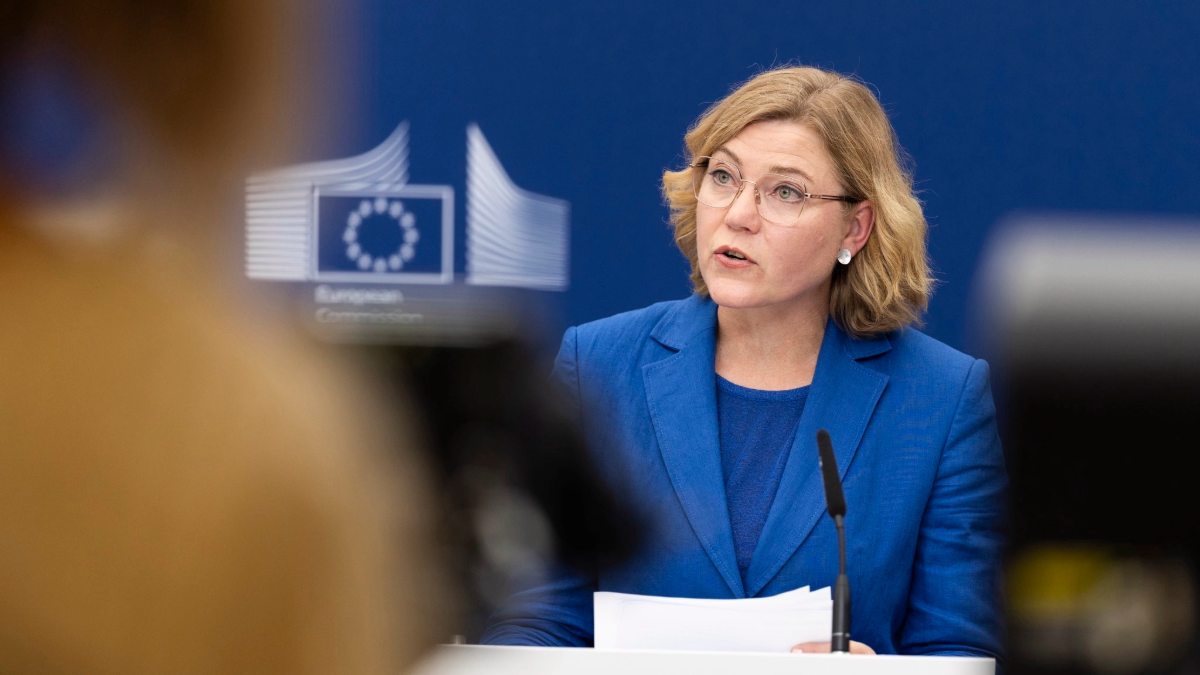China Export Controls Highlight EU’s Rare Earth Dependence in AI Race
Raluca Besliu / Nov 4, 2025
Henna Virkkunen, Executive Vice-President for Tech Sovereignty, Security and Democracy of the European Commission. Source
Europe’s race to lead in artificial intelligence could be derailed, not by a lack of talent or funding, but by a shortage of rare earths. On Friday, Brussels hosted a delegation of senior Chinese officials to discuss export controls on these critical materials, which power everything from semiconductors to electric motors. China dominates global supply, producing more than 60 percent of mined rare earths and controlling 85 percent of processing capacity, giving it immense leverage over technology supply chains worldwide.
EU Trade Commissioner Maroš Šefčovič announced that China confirmed its decision to delay the expansion of export controls—originally set to add five elements to the restricted list—would also apply to the EU. Despite this, the European Commission said on Monday that the scope of China’s export controls remains uncertain as the bloc has yet to receive formal confirmation.
The postponement followed a high-stakes meeting between US President Donald Trump and Chinese President Xi Jinping, though it was unclear whether the measure had been initially aimed only at Washington. The dispute has also affected Europe’s chip sector. The Dutch government recently took control of China-owned Nexperia over national security concerns after the US expanded export controls on its parent company, Wingtech, to include subsidiaries.
Nexperia produces key components such as transistors and diodes in the Netherlands, while assembly and testing take place in China. Beijing responded by restricting exports of Nexperia chips, disrupting supply chains and raising EU worries over dependence on Chinese technology. On Saturday, China announced it might loosen the ban for certain companies, which could bring the EU some relief.
But the relief is limited. Restrictions on seven rare earth elements — first imposed amid escalating trade tensions with Washington in April 2025 — remain in effect, with exports subject to Chinese government approval through a licensing system.
The effects of these measures were immediate. By May 2025, prices had surged: dysprosium oxide had tripled, terbium oxide more than doubled, and industries from AI chip manufacturing to automotive production were feeling the squeeze.
Commissioner Šefčovič has acknowledged the scale of the problem, noting that “we have had a not very positive experience with the issuing of export licenses for the rare earths.” According to him, only about half of EU applications had been “properly processed,” allowing companies to obtain the materials they needed.
EU’s AI ambitions meet supply constraints
These enduring restrictions highlight China’s influence in global technology supply chains at a moment when the EU is intensifying its ambitions to become a global AI leader. In October 2025, Europe unveiled its Apply AI Strategy, a EUR1 billion plan to accelerate adoption across ten sectors, including healthcare, robotics, and defense.
Presenting the strategy at the Italian Tech Week in Turin in October, European Commission President Ursula von der Leyen framed the Union’s AI push as a matter of competitive survival, pointing to rapid adoption in the US, China, and India. "AI adoption has to be widespread, and we want to speed it up," she said.
Yet the EU’s ambitions risk being constrained by the very materials that power AI innovation.
“China's rare earth export controls will inevitably impact and slow down Europe's Apply AI initiatives, prompting delays in innovation and AI diffusion,” stressed Charles Mok, a research scholar at the Global Digital Policy Incubator at Stanford University.
Brussels is pushing China for cooperation. Henna Virkkunen, the EU Commissioner for Tech Sovereignty, Security, and Democracy, told Tech Policy Press that China's restrictions are "impacting Europe and our tech sectors," adding that "the EU is taking its own actions."
In the short term, the Commission is engaging "intensively" with Chinese authorities to secure rare earth supplies, said Virkkunen in an email. Teams are holding video calls and meetings under the Export Control Dialogue, a framework upgraded following the July 2025 EU–China summit.
The effort depends on China acting as a “reliable partner,” Virkkunen said, and identifying “timely and constructive solutions.”
But experts warn that political tensions could complicate matters. Professor Christoph Lütge of the Technical University of Munich said such cooperation remains possible, but only under improved political conditions. "China can be a reliable partner, and there is potential for meaningful and cooperative engagement," he said in an interview. "But to achieve that, we need to foster a different political atmosphere."
Others argue that Europe should not only focus on diplomacy but also rethink how it approaches AI development itself.
“The Apply AI Strategy should not start with ‘AI first,’ but with ‘think first', ” said Julian Bothe, Senior Policy Manager for AI and Climate at AlgorithmWatch. “It depends on very material foundations, energy, water, and rare earth elements. AI can’t be ‘first’ when its very existence relies on these finite resources,” he said, adding that, “the EU should look at building smarter, not bigger models, so that with every step of development we need less computing power, not more."
Automakers on edge
Industry data underscores the strain. In June 2025, the European Association of Automotive Suppliers (CLEPA) revealed that several production lines had ground to a halt after running out of rare earth supplies. Major automakers, including BMW, also faced disruptions across their supply networks, though the company said its own plants continued operating normally.
BMW is now betting on rare-earth-free motor technologies, replacing conventional magnets with magnetic field systems in its latest generation of electric vehicles. Yet rare earths remain indispensable for smaller motors, powering components from windshield wipers to window mechanisms.
Even companies that have avoided direct shutdowns are watching the market closely. “We remain in close contact with our Tier 1 suppliers to monitor the situation and ensure the supply of rare earth parts,” Juliette Faucon, a spokesperson for Renault Group, told Tech Policy Press.
Looking to the long term
Beyond immediate pressures, the EU is working to diversify its supply of rare earths through the Critical Raw Materials Act. Targets include extracting 10 percent, processing 40 percent, and recycling 25 percent of Europe’s rare earth needs by 2030, while limiting reliance on any single external supplier to 65 percent.
Ursula von der Leyen also recently announced RESourceEU, a plan to diversify supply chains and recycle critical materials, with partnerships planned with Canada, Australia, and Kazakhstan.
Yet analysts remain skeptical. "I don't think this is realistic," said Professor Lütge. "They are looking now to find other partners for rare earths, like Australia and Canada, but they do not have nearly the same amounts as China."
Dysprosium refining, for example, is concentrated in a single facility in Wuxi, accounting for roughly 60 percent of the global total, making it nearly impossible to replace in the near term.
Without a swift solution, Professor Lütge warned, “This will widen the gap between the EU and China and the US when it comes to the AI race.”
Authors
